Learning how to write a lab report is a crucial skill for students and researchers alike. A well-written lab report not only documents the details of an experiment but also shows your understanding of the scientific process. Whether you’re new to writing reports or just looking to improve, this independent guide will guide you step-by-step through each part of the structure, helping you communicate your work clearly and effectively.
Introduction: Why Writing a Lab Report is Essential
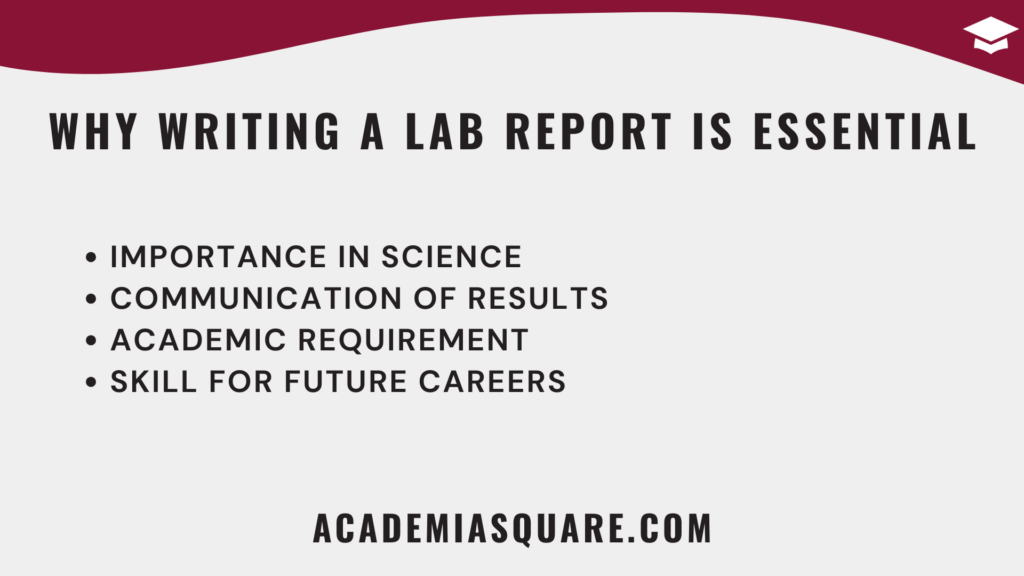
Writing a lab report is a crucial skill for anyone in the scientific field, whether you’re a student, researcher, or professional. A well-written lab report serves as a detailed record of your experiment, analysis, and conclusions. It’s not just a task to complete; it’s an essential way to communicate your findings to others. Understanding how to write a lab report effectively will help you showcase your research process, ensure reproducibility, and present your results in a logical, structured format.
Lab reports are not just academic exercises; they’re also a vital part of the scientific method. By learning how to write a lab report, you develop skills that are applicable across disciplines. Whether you’re conducting a biology experiment, testing a hypothesis in chemistry, or even conducting physics experiments, the structure of the report remains largely the same. This universality makes mastering how to write a lab report an important step in any scientific career.
The Purpose of a Lab Report
Before diving into the specifics of how to write a lab report, it’s important to understand its purpose. A lab report is intended to:
- Document your experiment: The report serves as a permanent record of what you did, how you did it, and what you found.
- Explain your results: It’s not enough to just report findings; you need to interpret them, drawing connections to the hypothesis.
- Demonstrate your understanding: Writing a lab report allows you to show how well you understand the scientific concepts behind the experiment.
- Communicate to others: A lab report ensures that your research can be understood and replicated by others.
Mastering how to write a lab report ensures that you can effectively communicate your research process and conclusions. It’s an essential skill that will be valuable throughout your academic career and beyond.
Importance of Clear and Accurate Reporting
When writing a lab report, clarity and accuracy are paramount. If your report is unclear or lacks detailed information, it’s difficult for others to understand or replicate your experiment. This is especially critical in scientific work where replication of results is a core principle. Additionally, accuracy in reporting ensures that the conclusions drawn from your experiment are based on solid data, free of errors or misinterpretations.
Research has shown that students who adhere to a structured approach when writing lab reports produce higher-quality work and are better able to communicate their findings. This reinforces the importance of learning how to write a lab report thoroughly and systematically.
What Is a Lab Report? A Clear Definition
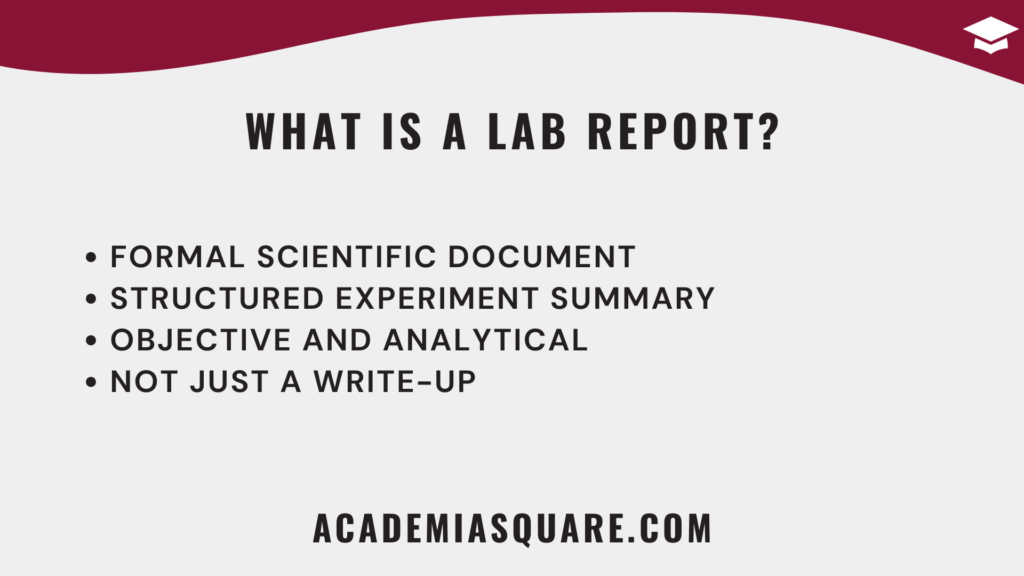
A lab report is a structured document that describes, explains, and analyzes a scientific experiment or research study. The purpose of writing a lab report is to communicate your research process, findings, and conclusions in a clear, logical format. Understanding how to write a lab report means knowing its core components and how they fit together to present your work effectively.
At its core, a lab report is a detailed record of an experiment, typically broken down into several sections, including the introduction, methods, results, discussion, and conclusion. Each section serves a unique function in the reporting process, ensuring that anyone reading your report can understand the objective of the experiment, the methods used, and the conclusions drawn.
Key Components of a Lab Report
To effectively communicate your findings, a lab report typically follows this structure:
- Introduction: The introduction explains the purpose of the experiment, presents the hypothesis, and discusses the background information relevant to the experiment.
- Materials and Methods: This section describes the materials used and outlines the step-by-step procedures followed during the experiment, ensuring it can be replicated.
- Results: The results section presents the data collected during the experiment, often using tables, graphs, or figures for clarity.
- Discussion: In the discussion, you analyze the results, interpret their significance, and compare them with the initial hypothesis.
- Conclusion: The conclusion summarizes the experiment’s outcomes and suggests possible future experiments or improvements.
By learning how to write a lab report, you become proficient at documenting each of these sections in a clear, concise manner, making sure all relevant details are included. This structure is universally accepted in scientific writing, allowing researchers and students to present their findings in a standard format.
The Importance of Clarity and Objectivity
Clarity and objectivity are key when writing a lab report. The aim is to present your research in a way that others can understand, reproduce, and build upon. If your report is too vague or subjective, it may leave room for misinterpretation or confusion. A well-written lab report is concise, objective, and free from personal opinions, allowing readers to focus on the data and analysis.
Research indicates that writing a well-structured, clear, and objective lab report is critical for success in academic and scientific settings. Mastering how to write a lab report with this in mind will help you develop strong scientific communication skills that are valued in any research field.
The Structure of a Lab Report: A Quick Overview
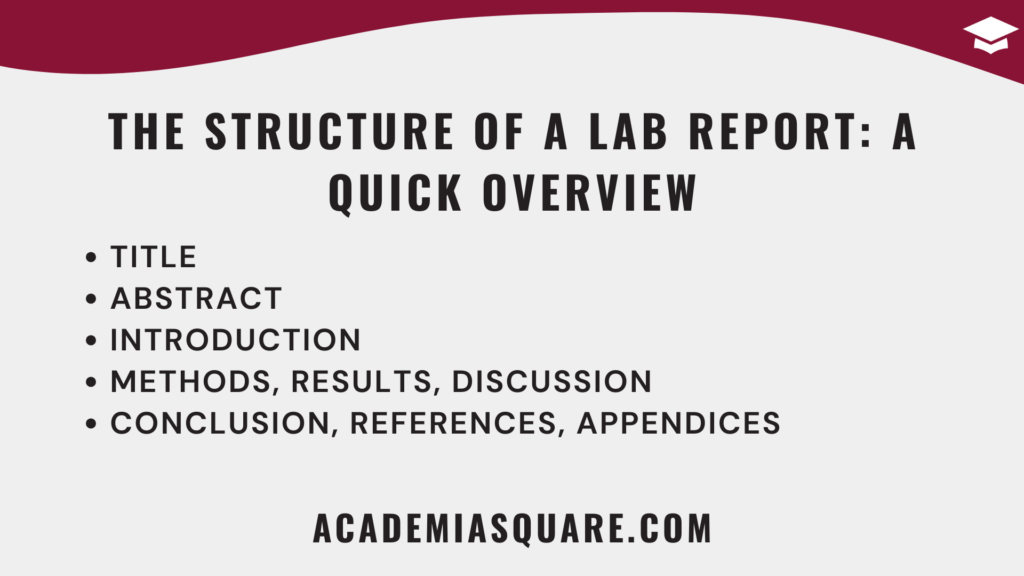
Understanding the structure of a lab report is essential for writing one that is clear, coherent, and scientifically rigorous. Each section of the lab report serves a specific purpose and is meant to guide the reader through the experiment in a logical sequence. Knowing how to write a lab report effectively begins with mastering its structure.
The typical lab report consists of the following sections: Introduction, Materials and Methods, Results, Discussion, and Conclusion. Each of these sections contributes to the overall flow of information, ensuring that your findings are communicated in a professional, scientifically valid manner.
Overview of Lab Report Sections
Here’s a quick rundown of the primary sections of a lab report:
- Introduction: This section provides the context for your experiment. It explains the hypothesis, research question, and any relevant background information. The introduction sets the stage for the entire report.
- Materials and Methods: In this part, you describe the materials used and outline the procedure followed during the experiment. This section should be detailed enough for someone else to replicate your work.
- Results: The results section presents the data gathered during the experiment. This can include numerical data, tables, graphs, or other visual aids to help clarify the findings.
- Discussion: This section is where you interpret the results. You analyze whether the results support or contradict the hypothesis and discuss any anomalies or unexpected findings.
- Conclusion: The conclusion summarizes the key findings of the experiment and suggests possible future research directions or improvements to the methodology.
Understanding how to write a lab report requires knowing that the order of these sections is important. They are designed to flow logically, guiding the reader from the purpose of the experiment all the way through to your final conclusions. Adhering to this structure ensures that your report is easy to follow and that each section serves its intended function.
Adapting the Structure Based on Experiment Type
While the basic structure remains the same for most lab reports, there are some variations depending on the type of experiment. For example, in certain fields like chemistry or physics, you might need to include additional sections like a theory or calculations section. However, the core structure remains a guide for any experiment, and learning how to write a lab report within this framework is essential for producing a professional and effective report.
The Title – Crafting an Accurate and Informative Title
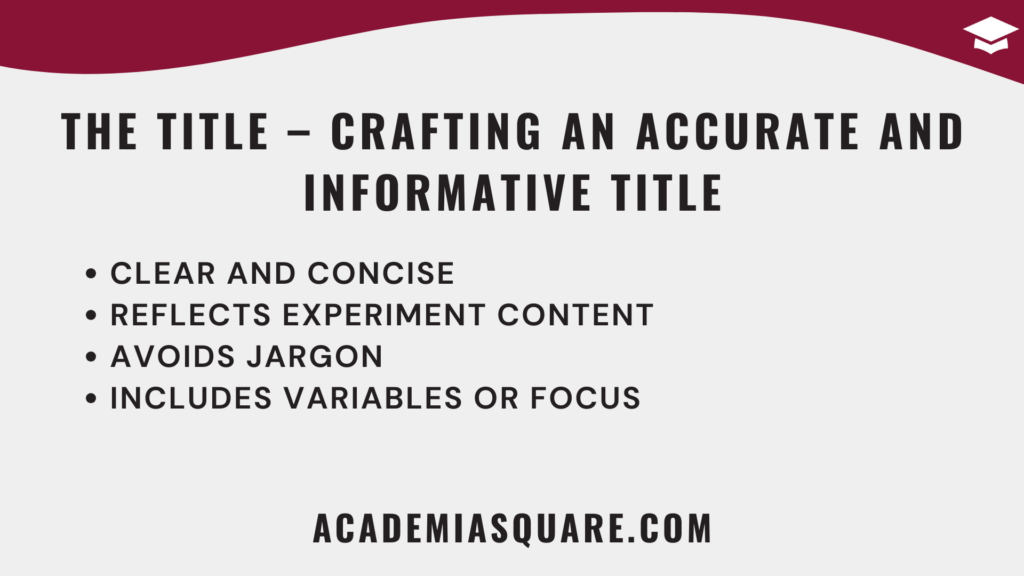
The title of your lab report is the first impression that readers will have of your work. It should be concise, clear, and informative. A well-crafted title serves as a roadmap for your entire report, giving readers a snapshot of the experiment’s focus and purpose. Understanding how to write a lab report begins with mastering the art of writing an effective title that captures the essence of your research.
What Makes a Good Lab Report Title?
A strong lab report title should fulfill several key functions:
- Be clear and descriptive: The title should clearly reflect the experiment’s aim or research question without being too broad or vague.
- Include key variables: It should mention the primary variables involved in the experiment, such as the substances, processes, or phenomena being studied.
- Be concise: A good title is not overly wordy. Aim for clarity and brevity, avoiding unnecessary jargon.
- Avoid unnecessary details: While your title should be descriptive, it shouldn’t delve into too many specifics. Save the details for the body of the report.
For example, a title like “The Effect of Temperature on the Rate of Enzyme Activity” is clear, concise, and directly related to the experiment’s objectives. It specifies the experiment’s focus (the effect of temperature), the subject (enzyme activity), and the key relationship being studied (rate).
Tips for Writing an Effective Lab Report Title
To craft a successful title for your lab report, keep these tips in mind:
- Focus on the experiment’s goal: Your title should immediately communicate what the experiment is testing or investigating.
- Use specific terminology: Avoid vague phrases like “a study of” or “investigating”—be specific about the experiment’s scope.
- Consider the audience: The title should be understandable to anyone in the field, but also concise enough to capture attention quickly.
Research has shown that well-titled reports are more likely to capture attention and provide clearer context for readers. Mastering how to write a lab report starts with perfecting the title—after all, it’s the first step in ensuring your work is taken seriously and can be easily understood by those who read it.
Title Variations Based on Experiment Type
While the general principles of title writing remain the same, some variation in format may occur depending on the experiment. For example, in certain types of experiments like clinical trials, you might include terms like “study” or “trial” in the title. However, the focus should always be on the experiment’s purpose and main variables, ensuring that the title remains accurate and clear.
By dedicating time and thought to crafting a strong, descriptive title, you’ll enhance the clarity of your report from the very beginning, setting the stage for the rest of your lab report.
The Introduction: Setting the Stage for Your Experiment
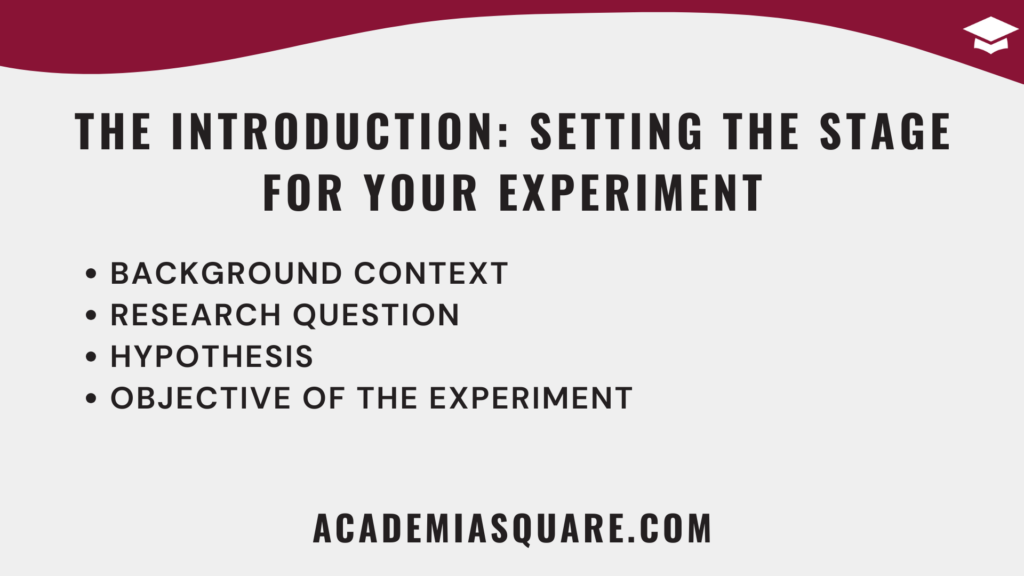
The introduction of your lab report is a critical section. It provides the context and background for your experiment, helping the reader understand why the experiment was conducted, what you were trying to investigate, and what you expected to find. Knowing how to write a lab report means recognizing the importance of a well-crafted introduction that sets the stage for the rest of the report.
What to Include in the Introduction
The introduction typically includes the following elements:
- Background Information: This section provides the necessary context for the experiment. You should briefly explain the relevant theories, concepts, and research related to the topic.
- The Research Question: Clearly state the research question you aimed to answer through the experiment. What problem were you trying to solve or hypothesis were you testing?
- The Hypothesis: If applicable, state your hypothesis—what you predicted the outcome of the experiment would be based on prior knowledge or research.
- Purpose of the Experiment: Describe the objective of the experiment and why it is important. What does the experiment seek to demonstrate or discover?
A good introduction provides the necessary background, explains the reason for the experiment, and introduces the hypothesis you’re testing. It should lay the foundation for understanding the experiment’s significance and help the reader follow the rationale behind your methods and results.
Why the Introduction is Crucial for Your Lab Report
Research indicates that a strong introduction is essential for setting expectations and guiding the reader through your scientific process. When writing how to write a lab report, it’s crucial to establish a clear framework for the experiment so the reader understands the purpose and scope of your research. A well-written introduction helps others easily grasp the significance of your study and how it fits within the broader scientific context.
Additionally, the introduction sets up the hypothesis, allowing the reader to keep it in mind when reviewing the results and discussion sections. By clearly stating your hypothesis, you allow for a more focused analysis of the findings and how they compare to what you originally predicted.
Keeping the Introduction Clear and Focused
It’s important to keep the introduction concise and to the point. Avoid unnecessary details or overly long explanations. While you want to provide enough information for the reader to understand the background and context, the introduction should not be a comprehensive review of the topic. Instead, focus on providing just enough information to set up your experiment and its purpose clearly.
Mastering how to write a lab report means being able to distill complex ideas into a clear and accessible introduction that immediately captures the essence of the experiment, making it easier for the reader to understand your research goals and methodology.
Materials and Methods: Detailing Your Experiment Process
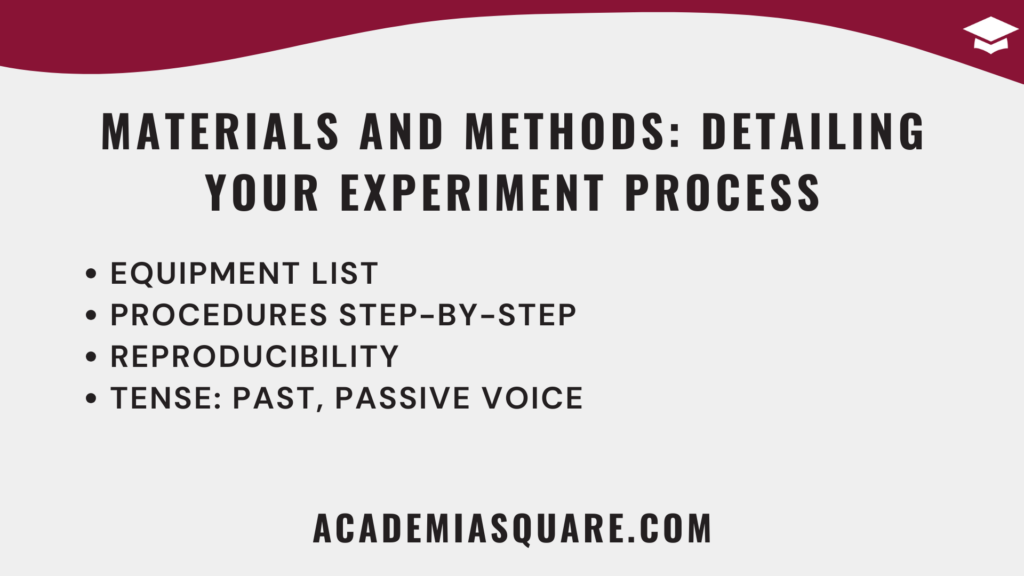
The Materials and Methods section of a lab report is crucial because it explains exactly how the experiment was conducted. This section ensures that your experiment is reproducible, allowing other researchers to replicate the procedure and verify your results. Knowing how to write a lab report means understanding that this section should be clear, precise, and thorough, providing all the necessary details about the materials used and the experimental procedures followed.
What to Include in the Materials and Methods Section
The Materials and Methods section typically includes the following elements:
- Materials Used: List all the materials, equipment, and instruments used in the experiment. Be as specific as possible, including model numbers, quantities, and any special conditions or specifications required for the materials.
- Experimental Procedure: Describe the step-by-step procedure followed during the experiment. This should be detailed enough that someone else could replicate the experiment using your description. It’s important to write this section in the past tense, as it reflects what has already been done.
- Controls and Variables: Specify the variables that were controlled, manipulated, and measured in the experiment. Include both independent and dependent variables, and explain how you controlled for extraneous variables to ensure the validity of your results.
- Statistical Analysis: If applicable, briefly describe the statistical methods used to analyze the data, such as averages, standard deviations, or statistical tests.
Being detailed and clear in this section is essential. If a reader cannot fully understand how the experiment was conducted, they cannot assess the reliability of the results. By learning how to write a lab report effectively, you ensure that every aspect of your experiment is documented clearly for reproducibility.
Writing Clear, Reproducible Methods
The goal of the Materials and Methods section is to provide sufficient detail so that another scientist could repeat the experiment and obtain similar results. This is why clarity and precision are so important. Avoid vague terms like “a small amount” or “several trials”—be specific about quantities, concentrations, and any other variables that may impact the results. The more detailed your description, the more reproducible your experiment becomes.
Research has shown that well-documented materials and methods help improve the transparency of the research process. Ensuring that others can reproduce your work strengthens the reliability of your findings. Thus, mastering how to write a lab report includes being meticulous in documenting every step of the experimental process.
Common Mistakes to Avoid in Materials and Methods
When writing the Materials and Methods section, there are several common mistakes to avoid:
- Vagueness: Avoid general statements that leave out key details or fail to specify measurements, equipment, or procedures.
- Omitting key details: Ensure that you provide enough information so someone else can replicate the experiment accurately. Missing critical steps or information can undermine the validity of your report.
- Using unclear terminology: Use precise, standard scientific terms when describing procedures, materials, and measurements.
Results: Presenting Your Data Clearly and Effectively

The Results section of your lab report is where you present the data collected during your experiment. It’s crucial that this section is clear, objective, and well-organized, as it forms the foundation for the analysis in the Discussion section. Knowing how to write a lab report means understanding that the Results section should focus on presenting data without interpreting it—interpretation comes later in the Discussion.
What to Include in the Results Section
The Results section typically includes the following elements:
- Raw Data: Include all the raw data you collected during the experiment. This can be in the form of tables, figures, or raw numerical data. Be sure to present this data in a clear, organized format so that it’s easy to read and understand.
- Processed Data: If applicable, include any data that has been processed or analyzed, such as averages, percentages, or statistical tests. Make sure to clearly label each result to indicate what it represents.
- Figures and Tables: Data should be presented in tables, graphs, or figures, as these formats make it easier to visualize and interpret the findings. Always refer to the tables and figures in the text, explaining what they show without restating the data point by point.
The goal of the Results section is to present your findings in a clear, straightforward manner, without interpreting them. While the Discussion section will focus on analysis, the Results should simply report what was observed in the experiment. When learning how to write a lab report, remember that the Results section should be a factual presentation of the data, with no personal interpretation or bias.
Presenting Data Clearly
To make your Results section as clear as possible, follow these tips:
- Organize your data: Arrange your data logically, grouping related results together. If you have multiple experiments or trials, make sure to present them in a way that’s easy to follow.
- Use visuals: Tables, graphs, and charts can be incredibly helpful in displaying data in a way that’s easy to understand. Make sure to label all figures and axes clearly, and include a title for each table or figure.
- Be consistent: Use consistent units of measurement, terminology, and formats for presenting data. Consistency helps the reader follow your results more easily.
Research shows that the use of visuals—such as tables and graphs—can greatly enhance the clarity of scientific data, allowing readers to process information more quickly. As you learn how to write a lab report, mastering the presentation of data in this way ensures that your results are presented in the most effective manner possible.
Common Mistakes to Avoid in the Results Section
When writing the Results section, there are several common mistakes to avoid:
- Overloading with raw data: While it’s important to include all relevant data, avoid overwhelming the reader with unnecessary raw data. Focus on the most important findings and use visuals to support them.
- Over-explaining: Avoid the temptation to explain or analyze the data in this section. Save your analysis for the Discussion section.
- Not referencing visuals: Always refer to tables, graphs, and figures in the text. Don’t simply list the data—explain what the reader should notice in each visual.
Discussion: Interpreting Your Results and Drawing Conclusions

The Discussion section is where you interpret the data you presented in the Results section. It’s the part of your lab report where you explain what your results mean in the context of your hypothesis and the existing body of scientific knowledge. Learning how to write a lab report means understanding that the Discussion is not just about summarizing your findings, but also analyzing them, making connections, and addressing any inconsistencies or unexpected outcomes.
What to Include in the Discussion Section
The Discussion section typically includes the following elements:
- Interpretation of Results: Explain what the results mean in terms of your hypothesis. Did the data support your hypothesis, or were the results unexpected? Provide an explanation for why the results turned out the way they did.
- Comparison to Existing Research: Compare your results with those from previous studies or theoretical expectations. Do your results align with or contradict the findings of other researchers? This helps situate your work in the broader scientific context.
- Possible Errors and Limitations: Acknowledge any sources of error in your experiment. Were there limitations to your methodology? Were there any variables that you were unable to control? Discuss how these factors might have impacted your results.
- Implications of Your Findings: Consider the broader implications of your findings. How do your results contribute to the existing body of knowledge? What further research could be conducted to build on your experiment?
The Discussion section allows you to demonstrate your understanding of the experiment and the field. It shows your ability to analyze data critically and offers insights into what the results might mean in the larger context. This is where you showcase your scientific reasoning skills and your capacity to think beyond the immediate experiment.
Interpreting Results and Understanding Their Significance
Interpreting results effectively is key to writing a strong Discussion section. A simple restatement of the results is not enough. You need to critically analyze the data and explain why it turned out the way it did. Research indicates that a strong Discussion not only answers whether the hypothesis was supported, but also explores why certain outcomes occurred, what unexpected results might mean, and what limitations impacted the experiment.
When interpreting your results, ask yourself the following questions:
- Did my hypothesis match the results? If not, what could explain the discrepancy?
- How do my findings compare to previous studies? Do my results align with or challenge what others have found?
- What were the sources of error? Were there any methodological issues that could have influenced my results?
Handling Unexpected Results
In scientific research, unexpected results are common, and it’s important to approach them with a critical mindset. Don’t dismiss surprising outcomes. Instead, explore possible explanations for why they occurred. Did the experiment fail in some way? Could there be an unaccounted-for variable influencing the outcome? Understanding how to write a lab report means acknowledging both the expected and unexpected, providing thoughtful interpretations, and suggesting future steps to investigate the anomalies further.
Research-backed strategies suggest that addressing the unexpected with thoughtful analysis shows a deeper level of understanding and scientific inquiry. It demonstrates that you are engaging critically with the results, rather than simply glossing over anomalies.
Conclusions and Further Research
In your conclusion, summarize the main points of the Discussion section, briefly restating the findings and their significance. Then, suggest areas for future research based on the limitations or unresolved questions from your experiment. What additional experiments could be conducted to further explore your hypothesis? How can the experiment be improved or expanded upon?
Mastering how to write a lab report involves being able to not only analyze your data but also think critically about the implications of your results and the next steps for further scientific inquiry. A strong Discussion section connects your findings with broader research and leaves the reader with a sense of what comes next in the field.
Conclusion: Wrapping Up Your Findings and Their Implications
The Conclusion section of your lab report is where you summarize the entire experiment, its results, and its implications. It provides a final opportunity to reflect on the significance of your work and suggest how your findings contribute to the broader field of study. Knowing how to write a lab report means understanding that the Conclusion should not introduce new information but instead provide a concise summary of the key takeaways from your experiment.
What to Include in the Conclusion Section
The Conclusion typically includes the following elements:
- Summary of Key Findings: Provide a brief recap of the most important results and whether they supported or contradicted your hypothesis. This is your chance to restate the major takeaways from the experiment.
- Implications of Your Findings: Discuss the broader implications of your results. What do your findings mean in the context of the field? How do they contribute to existing knowledge?
- Suggestions for Future Research: Reflect on any limitations in your study and propose areas for further investigation. Are there any unanswered questions or new directions that researchers could explore based on your work?
- Final Thoughts: Conclude with a brief, overarching statement that ties everything together. Reiterate the importance of the experiment and its findings in the scientific context.
The Conclusion is your chance to leave a lasting impression on the reader, so it’s important to be clear and concise. You want to summarize your experiment’s findings in a way that highlights their significance and suggests how they can be built upon in future research. When learning how to write a lab report, understanding the importance of a well-crafted conclusion is crucial for effectively summarizing the work and communicating its impact.
Why the Conclusion is Important
The Conclusion is an essential part of your lab report because it provides a final opportunity to communicate the significance of your findings. Without a clear and focused conclusion, your report may feel unfinished or lacking in purpose. Research indicates that a strong conclusion can help reinforce the importance of your work and solidify the understanding of its contribution to the scientific community.
In the Conclusion, you want to emphasize the main points without being redundant. A good conclusion brings everything together in a way that is easy to understand and highlights the broader impact of your experiment.
Common Mistakes to Avoid in the Conclusion Section
When writing the Conclusion, there are a few common mistakes to avoid:
- Introducing new information: The Conclusion should not introduce new data or experimental details. It should summarize what has already been presented in the report.
- Being overly vague: Avoid general statements that don’t provide clear insight into your findings. Your conclusion should be specific and highlight the importance of the results.
- Failing to suggest future research: Be sure to mention any unanswered questions or potential next steps in the research. This shows that you’ve critically reflected on the experiment’s limitations and how it can be expanded upon.
Understanding how to write a lab report includes knowing how to tie everything together in a meaningful way, ensuring that your report ends on a clear and impactful note.
References: Citing Sources and Giving Credit
The References section of your lab report is where you provide a list of all the sources you used throughout your research and writing process. Proper citation is essential in academic writing, as it acknowledges the work of others and allows readers to follow up on the sources that informed your experiment. Knowing how to write a lab report means understanding the importance of accurately citing references and the correct formatting style to use.
What to Include in the References Section
The References section typically includes:
- Books, Articles, and Journals: List any books, articles, or scientific journals that you consulted during your research. These sources provide the foundation for your experiment and may include theories, methodologies, or previous research that informed your work.
- Websites: If you referenced any online resources, make sure to cite them accurately, including the URL and the date you accessed the information.
- Lab Manuals or Protocols: If you followed a specific protocol or lab manual, cite it appropriately. These are often essential sources in experimental research.
- Personal Communications: If you consulted with experts, professors, or peers during your research, you may need to cite personal communications, such as interviews or emails, depending on the citation style you are using.
Remember that the References section is more than just a list—it is a way to provide credit to the original sources that contributed to your work. Whether you consulted academic papers, textbooks, or online resources, proper citation allows others to verify your sources and build upon your work.
Citation Styles: Choosing the Right Format
There are several citation styles commonly used in scientific writing, and choosing the right one depends on your field and your instructor’s preferences. Some of the most common styles include:
- APA (American Psychological Association): Often used in psychology, social sciences, and some natural sciences.
- MLA (Modern Language Association): Common in the humanities, but it is sometimes used for general academic writing.
- Chicago/Turabian: These styles are frequently used in history, economics, and some other disciplines.
- ACS (American Chemical Society): Used primarily in chemistry-related fields.
- IEEE (Institute of Electrical and Electronics Engineers): Frequently used in engineering and technical fields.
Each citation style has its own rules for formatting references, including how to list authors, titles, publication dates, and page numbers. When you learn how to write a lab report, it’s essential to follow the specific guidelines of the citation style you are required to use to ensure consistency and accuracy in your reference list.
Why Proper Citation Matters
Proper citation is crucial for several reasons:
- Academic Integrity: Citing your sources gives credit to the original authors and helps avoid plagiarism, which is a serious offense in academic settings.
- Supporting Your Claims: Citations back up your statements and provide evidence for your conclusions. By referencing established studies and research, you strengthen the credibility of your findings.
- Enabling Further Research: Citations allow readers to trace your sources, enabling them to verify your information and continue exploring the subject.
In scientific writing, the importance of proper citation cannot be overstated. Research has shown that clear and accurate references not only demonstrate the depth of your research but also provide readers with the tools to explore further. By mastering how to write a lab report, you learn to cite sources properly, ensuring that your work is both credible and transparent.
Common Citation Mistakes to Avoid
When citing sources, there are a few common mistakes to avoid:
- Inconsistent Formatting: Mixing citation styles or failing to format references correctly can make your report look unprofessional and can confuse readers.
- Incomplete Citations: Omitting essential details such as author names, publication dates, or titles can make it difficult for readers to verify your sources.
- Not Citing Secondary Sources: If you reference an idea or finding from another source that cites another researcher, make sure to cite the original author as well.
By being mindful of these citation practices, you can avoid errors and ensure that your references are accurate and properly formatted. This is an important part of learning how to write a lab report and maintaining the credibility and integrity of your work.
Appendices: Supporting Materials and Supplementary Information
The Appendices section of your lab report is where you include any supplementary information that is relevant to your experiment but too detailed or lengthy to be included in the main sections of the report. This may include raw data, additional figures or tables, calculations, or detailed descriptions of experimental procedures. Mastering how to write a lab report means understanding when and how to use the Appendices to provide full transparency and additional context to your findings.
What to Include in the Appendices Section
The Appendices section should include all the additional material that supports your experiment but doesn’t fit naturally within the main sections of the report. Common items to include are:
- Raw Data: Any data collected during your experiment, including measurements, observations, or calculations that were used to analyze your results.
- Figures and Tables: Include detailed charts, graphs, or tables that provide additional insight into your results but are too complex to be included in the Results section.
- Calculations: If you performed any calculations as part of the experiment, include the step-by-step process for clarity and transparency.
- Additional Methodological Details: If there were specific procedures or protocols that you followed, but which are too detailed to include in the Methods section, include them in the Appendices.
Make sure to reference any items you include in the Appendices within the main text of your lab report. For example, you might refer to “Appendix A” when discussing your raw data, ensuring that readers know where to find this supplementary material. Including this information helps demonstrate the rigor of your experimental process and provides all the necessary details for someone to replicate your work if they choose to do so.
Why the Appendices Matter
The Appendices section is essential for maintaining clarity and conciseness in your lab report. By placing detailed or supplementary information in the appendices, you keep the main body of your report focused and accessible while still providing all the necessary data. This organization makes your lab report easier to read and ensures that anyone who wants to examine the data in more detail can do so.
Additionally, the Appendices allow you to demonstrate thoroughness in your scientific work. Including all relevant data, calculations, and supporting material not only adds transparency to your report but also shows that you’ve taken a careful and comprehensive approach to your experiment. Research indicates that well-organized appendices enhance the readability of lab reports, making it easier for readers to follow your work without getting bogged down in unnecessary detail.
How to Format the Appendices
The Appendices should be clearly organized and easy to navigate. Here are a few guidelines to help you format them properly:
- Label each Appendix: Use clear labels such as “Appendix A,” “Appendix B,” etc., and give each appendix a brief title or description so that readers understand what it contains.
- Reference in the Main Text: Make sure to refer to the Appendices in the main body of your report. For example, “See Appendix A for the complete data set.”
- Organize Data Logically: Arrange your appendices in a logical order, typically in the order that you reference them in the main text.
- Keep It Neat and Readable: Present your information clearly and concisely. If you’re including tables or charts, make sure they’re easy to read and properly labeled.
By following these formatting tips, you ensure that your Appendices section enhances the overall structure of your lab report and provides supplementary material in a clear and accessible way.
Common Mistakes to Avoid in the Appendices
When working on the Appendices section, there are a few common mistakes to watch out for:
- Including irrelevant or excessive material: Only include data or information that directly supports your experiment. Don’t overload your Appendices with unnecessary material that doesn’t add value to your report.
- Not referencing your appendices in the main text: Make sure to refer to each appendix within the body of your report to guide the reader to the relevant information.
- Formatting issues: Poorly formatted tables, graphs, or calculations can confuse the reader. Always make sure your appendices are neat and well-organized.
Proper use of the Appendices allows you to present all relevant information in a well-organized manner, further demonstrating your thorough understanding of how to write a lab report.
Common Mistakes to Avoid When Writing a Lab Report
Even experienced researchers and students can fall into the trap of making simple mistakes when writing a lab report. Knowing how to write a lab report not only involves understanding the structure and format but also recognizing and avoiding common errors that can weaken your report’s effectiveness. In this chapter, we will highlight some of the most frequent mistakes and offer practical tips on how to avoid them.
1. Failing to Follow the Report Structure
One of the most critical mistakes when writing a lab report is failing to adhere to the standard structure. Each section of the lab report has a specific purpose, and deviating from this structure can confuse the reader or detract from the clarity of your findings. As you learn how to write a lab report, remember that the report typically follows this order: Title, Abstract, Introduction, Methods, Results, Discussion, Conclusion, and References.
By ensuring your report is clearly organized according to this structure, you make it easier for the reader to understand your research and its conclusions. Skipping sections or adding them out of order can disrupt the logical flow and make your report harder to follow.
2. Inconsistent Formatting
Inconsistent formatting throughout your lab report can make it look unprofessional and difficult to read. This includes things like inconsistent font sizes, headings, citation styles, and spacing. Adhering to a consistent formatting style throughout your report is essential for clarity and readability.
When learning how to write a lab report, pay attention to the guidelines for the citation style you’re using (e.g., APA, MLA, etc.). Properly format headings, subheadings, and figure captions, and make sure your text is aligned and properly spaced. These small formatting details can have a big impact on the overall quality of your report.
3. Lack of Clear and Concise Writing
Scientific writing should be clear, concise, and precise. One common mistake in lab reports is using overly complex language or unnecessary jargon that may confuse readers. Aim for simplicity and clarity, focusing on getting your points across effectively without overcomplicating things.
When writing, ask yourself whether each sentence adds value to the report. Avoid unnecessary repetition and wordiness. Being direct and to the point will make your findings much easier to understand and more compelling.
4. Failing to Provide Sufficient Details in Methods
The Methods section of your lab report is crucial because it explains how you conducted the experiment, allowing others to replicate it. A common mistake here is failing to provide enough detail. If your Methods section is vague or incomplete, it’s impossible for others to understand exactly how you performed your experiment, which compromises the validity of your findings.
When you’re learning how to write a lab report, ensure that your Methods section includes all relevant details, such as the equipment used, the experimental setup, the procedures followed, and any specific conditions or measurements. This information should be precise enough for someone to replicate your experiment step by step.
5. Not Interpreting Results Properly
One of the most significant errors is failing to interpret the results of your experiment correctly. Just presenting data without analyzing it in the context of your hypothesis and objectives can leave the reader without a clear understanding of the significance of the results.
The Results section should be more than just a presentation of data; it should also include an interpretation that connects the data to your initial hypothesis or research question. In the Discussion section, you will analyze and explain these results, discussing whether they support your hypothesis and what they imply for future research.
6. Poor Time Management
Writing a lab report often requires significant time and effort, and poor time management is a common pitfall. Rushing through the writing process or leaving parts of the report to the last minute can lead to incomplete or poorly thought-out sections.
When working on a lab report, start early and break the task into manageable parts. Allocate sufficient time for drafting, revising, and proofreading. By giving yourself enough time to complete each section thoroughly, you can avoid mistakes and ensure the quality of your work.
7. Overloading the Report with Unnecessary Information
While it’s important to include all relevant data and findings in your lab report, it’s equally important to avoid overloading your report with unnecessary information. Including excessive background details, unrelated studies, or irrelevant data can distract from the core message of your report.
Stick to the essentials and focus on the key findings of your experiment. By maintaining a focused narrative, you will ensure that your report is not only more concise but also more impactful.
8. Ignoring the Conclusion
Many students make the mistake of writing a weak or incomplete Conclusion. This section is your opportunity to wrap up your experiment and present the broader implications of your findings. A poor conclusion leaves the reader with an unclear sense of the significance of your work.
When learning how to write a lab report, remember that your conclusion should be a brief but insightful summary of your experiment, discussing what your findings mean and how they contribute to the field. It should also suggest any potential directions for future research.
9. Forgetting to Proofread and Edit
One of the simplest but most critical mistakes is failing to proofread and edit your lab report before submission. Even the best writers can overlook small errors, such as typos, grammatical mistakes, or awkward phrasing. These errors can detract from the professionalism of your report and distract from the quality of your content.
Always take the time to review your lab report before submitting it. Use proofreading tools and ask a peer or professor to read through it for additional feedback. A fresh pair of eyes can often catch mistakes that you might have missed.
10. Failing to Cite Sources Properly
Proper citation is a crucial part of any academic report. A common mistake is failing to cite sources or citing them incorrectly. This can lead to accusations of plagiarism, which can have serious academic consequences.
Make sure to cite all the sources that you refer to in your lab report, including articles, textbooks, and online resources. Follow the citation style required by your instructor or field of study (e.g., APA, MLA, Chicago) and ensure that your references are complete and formatted correctly.
Understanding how to write a lab report involves not only mastering the structure and content but also ensuring that your report is free from errors that could undermine its effectiveness.
Lab Report Examples and Templates
When learning how to write a lab report, one of the best ways to gain clarity and improve your writing skills is by using real lab report examples and templates. In this chapter, we’ll provide you with practical templates and examples that you can follow and modify to suit your needs. These examples will help you understand how to structure your lab report effectively, while the templates can serve as a starting point for your own reports.
Example 1: Full Lab Report (Basic Structure)
This example demonstrates a simple lab report with the basic structure that you should follow. The sections are clearly labeled, and the writing is concise and focused.
Title: Effect of Temperature on the Rate of Enzyme Activity
Abstract: This experiment aimed to investigate how different temperatures affect the rate of enzyme activity in a controlled setting. The results showed that enzyme activity increased with temperature up to a point, after which it decreased, suggesting an optimal temperature for the enzyme’s activity. A peak rate was observed at 37°C, with enzyme activity decreasing at higher temperatures.
Introduction: Enzymes are biological catalysts that accelerate chemical reactions. The activity of enzymes can be influenced by several factors, including temperature. This experiment investigates how temperature variations affect enzyme activity, specifically in the case of amylase, an enzyme involved in the breakdown of starch.
Methods:
1. Prepare three test tubes with starch solution and add an equal amount of amylase enzyme to each.
2. Place the test tubes in water baths set to 20°C, 37°C, and 50°C.
3. Measure the rate of reaction by observing the time taken for starch to be broken down, indicated by the disappearance of a blue color after adding iodine.
4. Record the results and analyze the data.
Results: The experiment produced the following results:
- At 20°C, enzyme activity was slow, with starch breakdown taking approximately 10 minutes.
- At 37°C, the reaction was much faster, with complete breakdown occurring in 3 minutes.
- At 50°C, the enzyme activity slowed down again, taking 12 minutes for starch breakdown to complete.
Discussion: The results demonstrate that enzyme activity increases with temperature up to an optimal point (37°C). Beyond this temperature, the enzyme’s structure starts to denature, leading to decreased activity. This suggests that enzymes have an optimal temperature range for maximum efficiency.
Conclusion: Temperature significantly affects enzyme activity. The optimal temperature for amylase activity was found to be 37°C. Future experiments could explore the effects of other environmental factors on enzyme activity.
Example 2: A Lab Report Template (Generic)
Use the following template to structure your own lab reports. Replace the placeholder text with your specific data and findings. This template provides the essential structure, ensuring you don’t miss any critical section.
Title: (Insert title of your experiment)
Abstract: (Provide a brief summary of the experiment, including the research question, methods, results, and conclusion. Keep it under 250 words.)
Introduction:
- State the background information relevant to the experiment.
- Explain the research question or hypothesis.
- Discuss the purpose of the experiment and why it is being conducted.
Methods:
- Describe the materials and equipment used in the experiment.
- Explain the procedures in clear, step-by-step instructions.
- Ensure the methods are detailed enough for replication by others.
Results:
- Present the data in tables, graphs, or charts where applicable.
- Provide a clear summary of the findings (without interpretation).
Discussion:
- Interpret the results, explaining their significance and any unexpected findings.
- Compare your results with previous research or expected outcomes.
- Discuss any limitations or sources of error in the experiment.
Conclusion:
- Summarize the main findings.
- State whether the hypothesis was supported or refuted.
- Suggest future research or improvements to the experiment.
References: (List all sources cited in your lab report in the appropriate citation style.)
Lab Report Template for Advanced Experiments
If you’re conducting more advanced experiments, here’s a comprehensive template for a detailed lab report. This template includes all the necessary sections and subsections to ensure you cover every aspect of your experiment.
Title: (Insert the title of your experiment)
Abstract:
- Provide a brief summary of the objectives, methods, results, and conclusions.
- Keep this section to 200-250 words.
Introduction:
- Define the scientific principles underlying the experiment.
- State the hypothesis or research question you aimed to answer.
- Explain the objectives and significance of the experiment.
Materials and Methods:
- List all materials, chemicals, and equipment used in the experiment.
- Provide step-by-step instructions on how the experiment was conducted.
- Include diagrams or photos if necessary to clarify complex methods.
Results:
- Present data in a clear, logical format (e.g., tables, graphs, and figures).
- State all observations and results objectively without interpretation.
Analysis and Discussion:
- Analyze and interpret the results, offering explanations for observed trends.
- Relate the results to the hypothesis and discuss whether they support or refute it.
- Address any sources of error and suggest ways to improve the experiment.
Conclusion:
- Summarize the key findings and their implications for future research.
- Restate the significance of the experiment and offer suggestions for future studies.
References: (Include all references using the appropriate citation style.)
Appendices: (Include any supplementary materials, such as raw data, calculations, or extended figures.)
By using these examples and templates, you’ll have a solid foundation for writing your own lab reports. Whether you’re working on a basic experiment or a more advanced study, these resources will guide you through the process and ensure your report meets academic standards. As you continue learning how to write a lab report, remember to tailor your approach to the specific requirements of your experiment and field of study.
FAQs – How to Write a Lab Report
How do you start a lab report?
To start a lab report, begin with a descriptive title that reflects the focus of your experiment. Then write an introduction that provides background information, explains the scientific concept being investigated, states the purpose of the lab, and includes any hypotheses. A well-structured introduction helps the reader understand the experiment’s context and relevance, as recommended by many academic writing guides, including Purdue OWL.
What makes a good lab report?
A good lab report is clear, concise, and logically organized. It includes all essential sections—title, abstract, introduction, methods, results, discussion, and conclusion. High-quality reports use accurate data presentation (e.g., charts, tables), cite sources appropriately, and follow a consistent formatting style such as APA or MLA. According to the University of Manchester’s academic writing center, clarity, objectivity, and structure are key to an effective report.
How do you do a lab report write-up?
To write up a lab report, follow a structured approach: begin with the title and abstract, then include the introduction, materials and methods, results, discussion, and conclusion. Use past tense for procedures and results, and present tense for established facts. Each section should serve a specific purpose, as outlined in academic standards like those found in the ACS (American Chemical Society) or APA guidelines.
How do you write the results section of a lab report?
In the results section, you should present your data clearly without interpretation. Use visuals like tables, graphs, or charts to summarize findings, and accompany them with brief textual descriptions. Avoid explaining what the results mean—save that for the discussion. According to the University of Toronto’s lab writing guide, clarity and logical sequence are vital for this section’s effectiveness.
What should be included in the discussion section of a lab report?
The discussion interprets your findings and links them to your hypothesis and theoretical background. You should explain trends, anomalies, or patterns in the data, compare results with existing research, and discuss any experimental limitations. The discussion often concludes with suggestions for further investigation. According to many university writing centers, this section demonstrates your critical thinking and understanding of the scientific process.
How long should a lab report be?
Lab report length varies depending on the level of study and complexity of the experiment. For undergraduate science courses, reports are typically 4–10 pages. Institutions may have specific formatting or length requirements, so it’s best to follow your instructor’s rubric. Conciseness and clarity should always take priority over length, as noted in guidelines from the University of Wisconsin Writing Center.
Do I need to include references in a lab report?
Yes, referencing is essential in a lab report when you use information from textbooks, journals, or other external sources. Citations demonstrate academic integrity and help readers trace your research foundation. The APA Publication Manual (7th edition) emphasizes that all scientific writing should clearly acknowledge its sources through in-text citations and a reference list.
What tense should I use when writing a lab report?
Use past tense when describing the procedures and results, since the experiment has already occurred. Present tense can be used for discussing theories, established facts, or visuals (e.g., “Figure 1 shows…”). This tense usage is supported by the APA guidelines and many university writing programs, which encourage consistency throughout your report.
Should I include an abstract in a lab report?
Yes, an abstract is a standard component of most lab reports. It provides a brief overview of the purpose, methodology, major findings, and conclusion of the experiment. The APA 7th edition recommends keeping the abstract between 150 and 250 words. It should help readers quickly understand the core of your work without reading the full report.
What is the difference between results and discussion in a lab report?
The results section presents data from your experiment in an objective, factual way—usually using tables or graphs. In contrast, the discussion analyzes that data, explains its significance, and interprets what the findings mean in the context of your hypothesis. This separation is standard in academic science writing and helps maintain clarity between evidence and interpretation.
Sources and Recommended Reading on Writing Lab Reports
- Day, Robert A. “How to Write and Publish a Scientific Paper.” Oryx Press, 1983. (Classic guide on scientific writing)
- Wallwork, Adrian. “Academic Writing for International Students of Science.” Springer, 2016. (Comprehensive resource for science students)
- McMillan, Victoria E. “Writing in Biology.” Bedford/St. Martin’s, 2006. (Focused on biology lab reports)
- OpenStax: Biology 2e – Introduction to Scientific Thinking and Reporting
- The University of North Carolina at Chapel Hill Writing Center – Scientific Reports
- Colorado State University Writing Guide – Writing Lab Reports
- Simon Fraser University – How to Write a Lab Report
- Monash University – Lab Report Structure and Style
- Academia Square – 10 Effective Study Techniques Every Student Should Know


